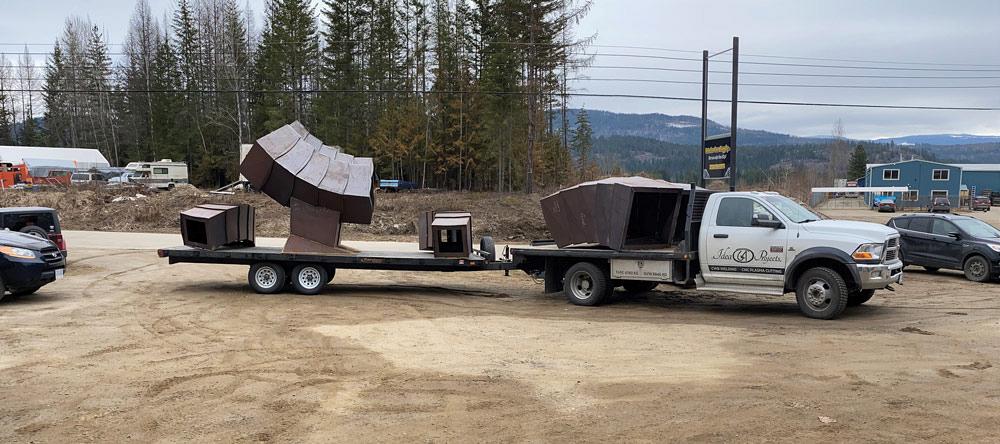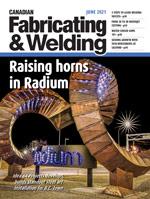Editor
- FMA
- The Fabricator
- FABTECH
- Canadian Metalworking
Raising horns in Radium
Idea 64 Projects develops, builds standout steel art installation for B.C. town
- By Rob Colman
- June 16, 2021
- Article
- Fabricating
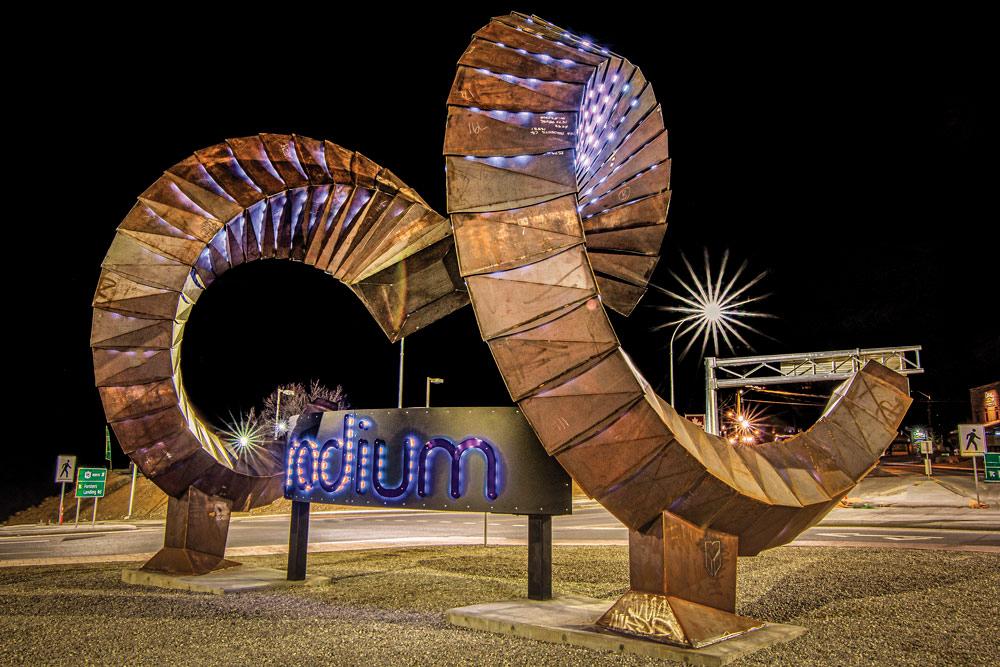
“There is 1,050 ft. of LED tape, 320,250 lumens across the two horns,” said Chris Meikle. Photo: Chris Conway Photography / www.chrisconway.ca
When most people think of metal and horns, it usually involves thrashing around at an Iron Maiden concert. But for Idea 64 Projects owner Chris Meikle, it’s more likely to remind him now of the steel sculpture of the curling horns of a bighorn mountain sheep he and his team built for a traffic circle in Radium Hot Springs, B.C.
Salmon Arm, B.C.-based Idea 64 Projects worked on the project with Chris’s brother Adam, a local artist who conceived the design.
“This was quite an open bid,” said Meikle. “The community had a lot of options of what it could be. It’s great to have that creative leeway.”
Design Challenge
The idea behind the piece, which stands 20 ft. tall, 40 ft. wide, and 20 ft. deep, was to speak to both the history and the future of bighorn sheep in Radium. It was inspired by the Radium-Stoddart herd, which is 140 animals strong and sometimes comes off the steep slopes nearby, right into the village.
Getting the design right took a lot of work.
“It involved a lot of engineering,” said Meikle. “We first considered doing it as a skeleton made out of high-strength steel and then cladding it with a material that would be painted. But cost-wise that would have been astronomical. It was then that we looked at it from a different lens and decided to go with a unibody kind of shape that involved the cladding being the structure as well.”
The horns are made up of boxes that increase in size by about 2 in. with each successive box. The smallest has a 26-in. diameter, the largest over 6 ft.
“Each of the panels has a bend that offsets the top from the bottom slightly, creating the perfect spiral you see in the final construction,” said Meikle.
He chose 3/16-in. high-strength weathering steel (COR-TEN) for the construction.
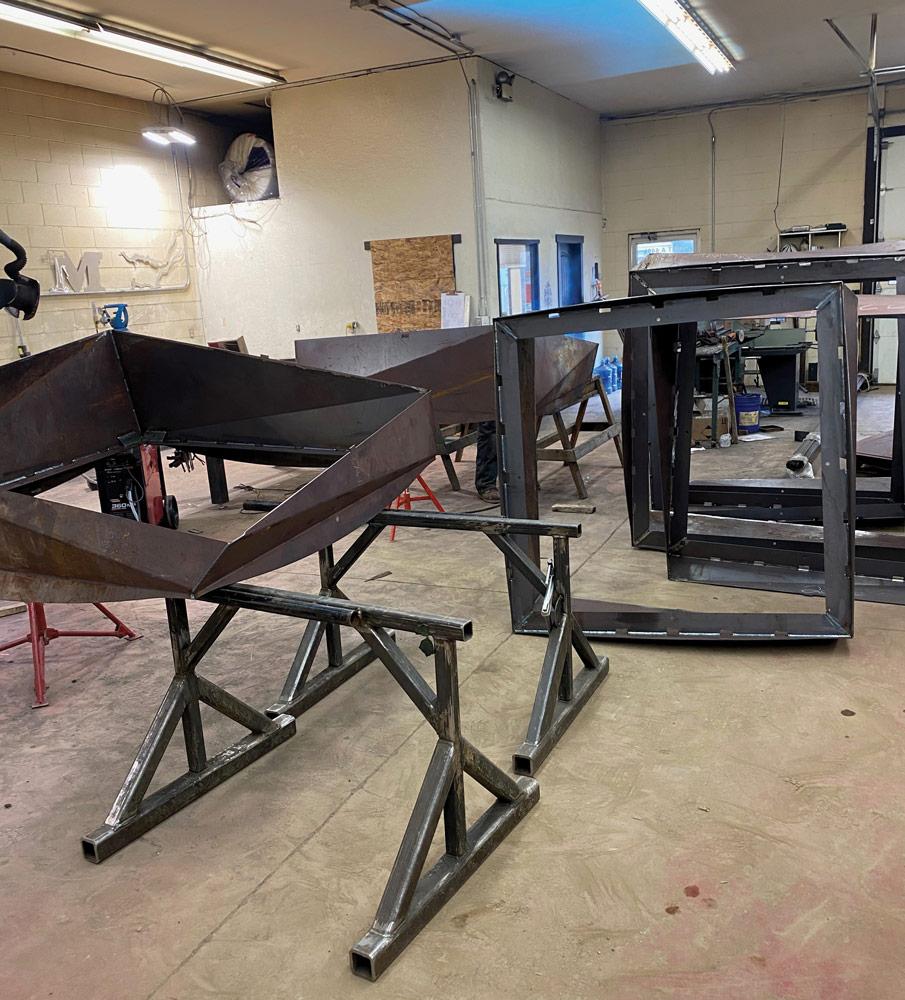
Here we see the Idea 64 Projects team working on sections of the horns in the company’s shop. Photo: Idea 64 Projects
“You just can’t replicate the colour you get using that,” he said. “It’s so unique. You can spend a lot of money on paint and never get there.”
Meikle used Solidworks for all the drawings; the drawings were done in consultation between Idea 64 Projects, Meikle Studios, Tegart Engineering, and Steve Baker. Once the concept was set, they did wind and snow load calculations with the software to make sure it was safe.
“Another important aspect of the design was that we wanted the horns to be freestanding,” he said. “We didn’t want the look to be marred by a spider web of supports holding it. And we also wanted there to be an impact on the viewer. I want people to wonder, ‘How is that actually standing?’”
As Meikle explains it, the structure itself is very rigid and held in place by a substantial amount of concrete supplied by Max Helmer Construction.
Fab and Assembly
Once the design was set, Meikle created the drawings to send out to Laser-Fab in Strathmore, Alta., which cut and bent most of the steel used in the horns.
“We cut the sign that stands between the horns along with the tips of the horns on our plasma machine, but Laser-Fab has a very precise press brake and fast laser-cutting capabilities that just made sense to use for this job.”
Meikle enjoys the partnerships he’s able to create with other fabricators.
“We are a CWB certified structural steel shop with fabricating capabilities,” he said. “But ultimately I think of us as a business that can think creatively through projects and manage them effectively.”
The actual fabrication of the horns certainly tested the abilities of the Idea 64 team.
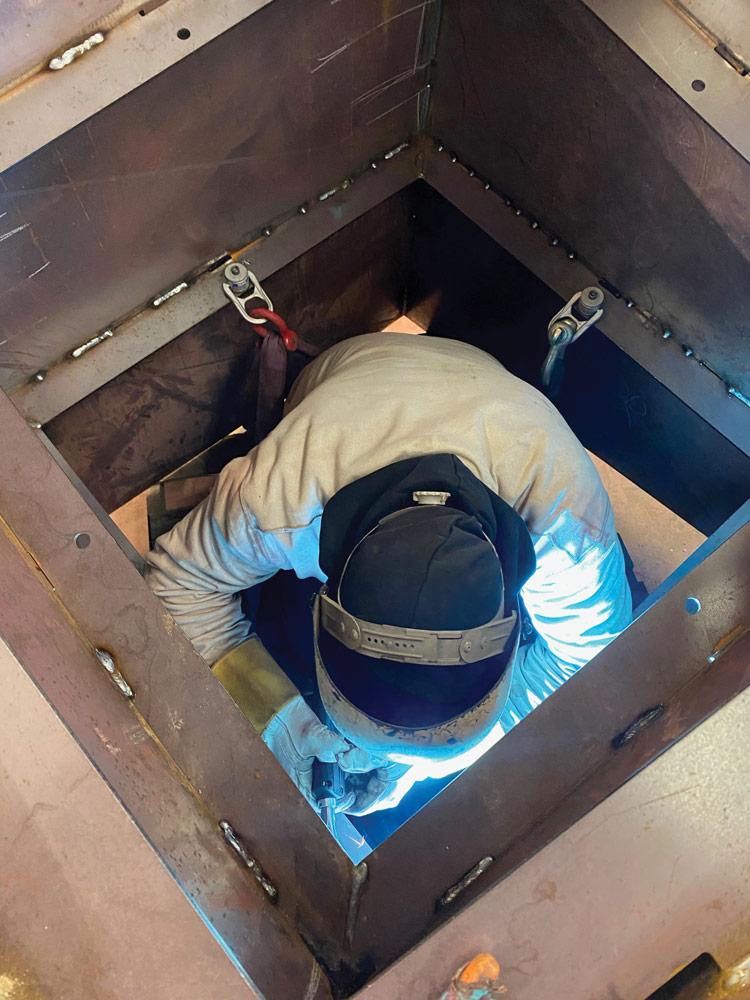
Here we see the Idea 64 Projects team working on sections of the horns in the company’s shop. Photo: Idea 64 Projects
“There was a ton of welding in that structure,” said Meikle. “I was welding from first thing in the morning until midnight every day, and it took a team of three of us a full three weeks to weld, with additional support from a fourth team member. It required a ton of welding, as well as grinding to prep for the weld. We went through eight 22-kg rolls of wire and four tanks of gases to get the job done.”
The process was complicated by the fact that LEDs had to be strung by electricians from Bolt Electric inside the horn just ahead of each part being welded on.
“There is 1,050 ft. of LED tape, 320,250 lumens across the two horns,” he said. “The effect is pretty amazing, though. The light is directional, inset so that you see the structure slightly differently from every angle.”
Finding the Best Way
Meikle is no stranger to unique jobs of this kind. He started out working in his family’s fab business, where he was involved a number of custom jobs that required, as he puts it, “doing gizmos” – creating and installing contraptions that would allow home owners to move walls or lift roofs off rooms; using counterweights these adjustments could be made by cranking a wheel.
“I spent four years in the field installing this kind of thing and then decided to strike out on my own,” he said. “My first job in my own shop was to build a moveable deck that would move away to allow access to a climbing wall. That kept me busy for four months.”
Meikle started out in his garage and now has his own facility and a team of four welders. His wife also works in the business.
And the Radium project isn’t his first large-scale public installation. His first was a gigantic treble clef that was installed on a building in Salmon Arm. The full structure of the treble clef, stave, and notes stands 44.7 ft. high and 29.5 ft. wide and weighs 2,770 lbs.
“We do a lot of regular steel work as well, but this stuff is very cool to do,” he said. “I want to leave something behind that’s interesting. It’s important to me that I not be afraid to tackle a problem, not be afraid to find a way that I can get the result that I want. In the end, if you have that attitude, the client wins and the public wins because you find a way to create something remarkable that people will enjoy looking at.”
Editor Robert Colman can be reached at rcolman@canadianfabweld.com.
Idea 64 Projects, www.idea64projects.ca
Laser-Fab, www.laser-fab.com
About the Author

Rob Colman
1154 Warden Avenue
Toronto, M1R 0A1 Canada
905-235-0471
Robert Colman has worked as a writer and editor for more than 25 years, covering the needs of a variety of trades. He has been dedicated to the metalworking industry for the past 13 years, serving as editor for Metalworking Production & Purchasing (MP&P) and, since January 2016, the editor of Canadian Fabricating & Welding. He graduated with a B.A. degree from McGill University and a Master’s degree from UBC.
subscribe now


Keep up to date with the latest news, events, and technology for all things metal from our pair of monthly magazines written specifically for Canadian manufacturers!
Start Your Free Subscription- Industry Events
Automate 2024
- May 6 - 9, 2024
- Chicago, IL
ANCA Open House
- May 7 - 8, 2024
- Wixom, MI
17th annual Joint Open House
- May 8 - 9, 2024
- Oakville and Mississauga, ON Canada
MME Saskatoon
- May 28, 2024
- Saskatoon, SK Canada
CME's Health & Safety Symposium for Manufacturers
- May 29, 2024
- Mississauga, ON Canada













